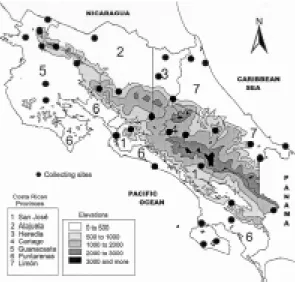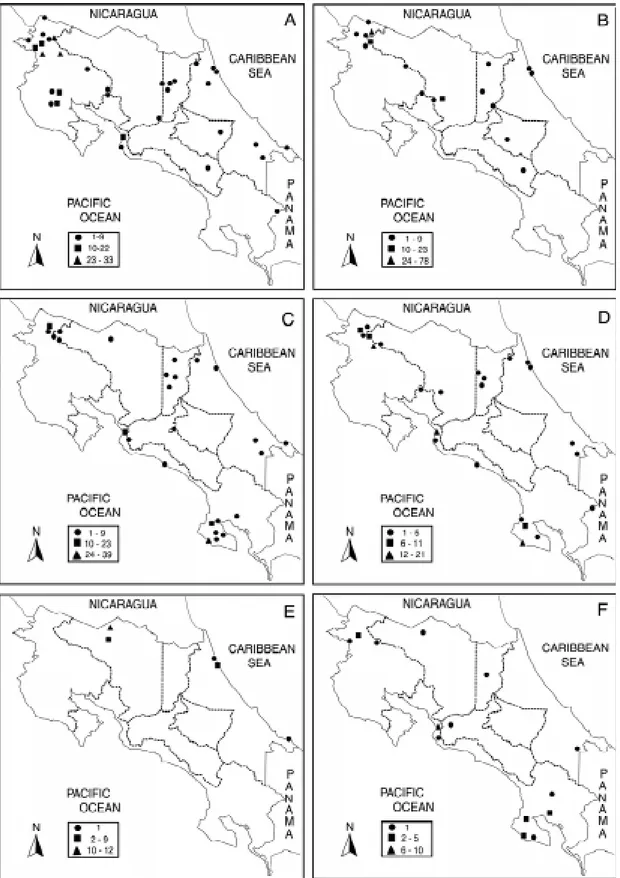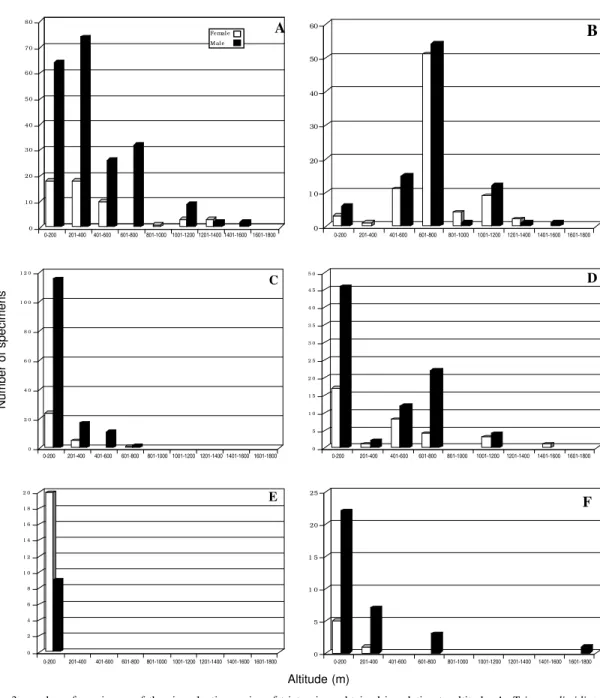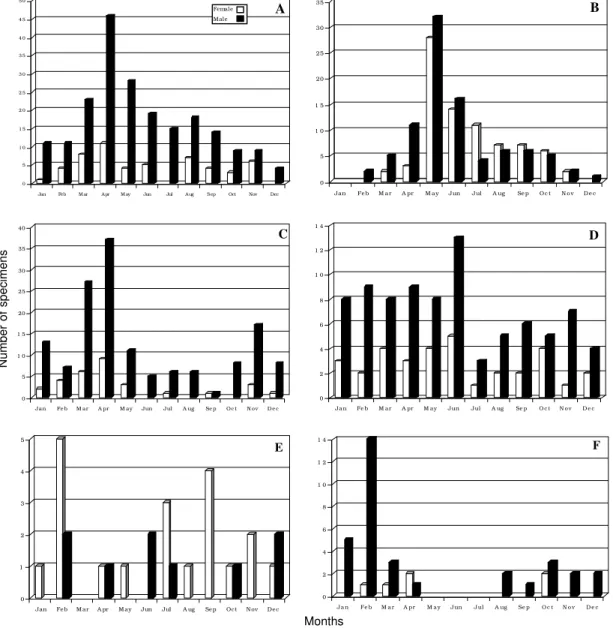Entomological and Ecological Aspects of Six Sylvatic Species
of Triatomines (Hemiptera, Reduviidae) from the Collection
of the National Biodiversity Institute of Costa Rica,
Central America
Rodrigo Zeledón/
+, Jesús A Ugalde*, Luis A Paniagua*
Escuela de Medicina Veterinaria, Universidad Nacional, Apartado Postal 86, Heredia, Costa Rica *Instituto Nacional de Biodiversidad, Santo Domingo, Heredia, Costa Rica
A total of 797 specimens of wild adult triatomines, belonging to six species from the entomological collections of the Costa Rican National Biodiversity Institute, was studied from the standpoint of their relative abundance, as reflected by light traps, distribution in the country, seasonal variations and climatic and altitudinal preferences.
Triatoma dimidiata was the most abundant species (32.9% of the total specimens), with a very exten-sive distribution in different ecological zones, being more common between 100 to 400 m above sea
level mainly at the end of the dry season. T. dispar was the third in frequency (21.5%), with narrower
distribution, more abundant between 600 to 800 m and scarce during the dry season. Panstrongylus
geniculatus and P. rufotuberculatus, second and fourth in frequency (22.1% and 15.1%, respectively), were widely distributed on both the Pacific and Caribbean basins, the former being more common
between 80 to 270 m all year round and the latter below 800 m mainly during the first semester. Eratyrus
cuspidatus which represented only 4.9% of the insects, was also present on both basins mainly below 200 m with a tendency to be scarce during certain months of the year, and was found in all types of
ecological zones. Finally, Rhodnius pallescens, the least abundant species (3.6%) was restricted to very
humid areas below 20 m, on the north side and Caribbean basin. With the exception of R. pallescens,
males were more commonly found than females. Some epidemiological implications related to the six species are discussed.
Key words: triatomine - sylvatic species - Costa Rica
In their check list of the Reduviid bugs of Costa Rica, Coscarón and Jirón (1988), cited the follow-ing species of triatomines as reported for the coun-try: Belminus costaricensis, B. rugulosus [this spe-cies, as indicated by Herrer et al. (1954), corre-sponds to B. costaricensis], Eratyrus cuspidatus
[the report is attributed to Lent and Wygodzinsky (1947), but this publication does not mention the species, nor is it cited as present in Costa Rica by Lent and Wygodzinsky (1979), in their mono-graph], Panstrongylus geniculatus, P.
rufo-tuberculatus, Rhodnius prolixus [this species
en-ters Costa Rica with Nicaraguan immigrants but it was immediately eliminated as stated by Zeledón (1996)], R. pallescens, Triatoma dimidiata, T.
dispar, T. nitida and T. ryckmani. All the above
+Corresponding author. Fax: +506-225.3633. E-mail:
rzeledon@sol.racsa.co.cr Received 26 October 2000 Accepted 8 March 2001
records, with the exception of T. dimidiata, were based on the finding of one or a few specimens.
Since its creation in 1989, the Costa Rican Na-tional Biodiversity Institute (INBio) has aimed to carry out, among other goals, a national insect in-ventory. By taking advantage of the numerous specimens belonging to six of the above mentioned species, deposited in INBio’s entomological col-lections, we report here some details of their rela-tive abundance, their distribution, seasonal varia-tions and their relavaria-tionships with some climatic conditions.
MATERIALS AND METHODS
from 83 to 86º West longitude. The specimens were collected by lights traps and the different collect-ing sites are indicated in Fig. 1.
Computer correlations were made with distri-bution, altitude, sex and relative abundance dur-ing the year and ecological regions by usdur-ing Arc View, Version 3.1 software.
ception of the south Pacific side and north central region where it was not found. T. dispar tends to be more common in the highlands, which run from northwest to southeast in the middle of the coun-try, and towards the northern lowlands and the Caribbean basin, while it is absent from the Pa-cific side and southeast mountains. This species represented 21.5% of all specimens, being third in frequency. P.geniculatus and P. rufotuberculatus
are widely distributed in the lowlands of both the Pacific and the Caribbean basins but they are also represented on the northwest Pacific slopes and some central highlands. Together with T. dimidiata
and E.cuspidatus, these two species reach higher
concentrations in the Pacific side of the country.
P. geniculatus and P. rufotuberculatus account for
22.1% (second in frequency) and 15.1% (fourth in frequency), respectively, of the specimens col-lected. R.pallescens was found only in the low-lands of the north side and in the Caribbean basin, whereas E.cuspidatus is present mainly along the Pacific basin, although it is also found on the Car-ibbean side. R.pallescens was the least frequent species encountered (3.6% of the total) followed
by E.cuspidatus (4.9%).
The Province that provided most specimens was Guanacaste (49.2% of the total for the country) with an evident predominance of T. dimidiata (54.6% of the specimens from this Province) followed by
T. dispar (26%). In second place was the Province
of Puntarenas with 26.9% of the total and a pre-dominance of P. geniculatus (50.9% of the speci-mens). In third place was the Province of Alajuela with 11% of the insects and a predominance of T.
dispar (59.1% of the specimens). The Province of
Limon provided 7.7% of the total insects and the Provinces of Heredia, San Jose and Cartago, only 3.8%, 1% and 0.5% respectively (Table I).
As far as their distribution in relation to altitude is concerned, T. dimidiata occurs from sea level to 1,520 m, with a higher concentration between 100 Fig. 1: map of Costa Rica showing the location of the 33
col-lecting sites where insects were captured.
RESULTS
The species found and their numbers, in pa-renthesis, were: T. dimidiata (262), T. dispar (171)
P. geniculatus (176), P. rufotuberculatus (120), R.
pallescens (29) (confirmed by Dr J Jurberg,
Instituto Oswaldo Cruz, Rio de Janeiro, Brazil),
and E.cuspidatus (39).
In Fig. 2 the distribution of the six species is observed. T. dimidiata, the most common species (32.9% of the total specimens found), has a very extensive distribution in the country with the
ex-TABLE I
Number of specimens of triatomines distributed by provinces and by sex
Provinces
Species Alajuela Cartago Guanacaste Heredia Limón Puntarenas San José Totals
E G E G E G E G E G E G E G
Triatoma dimidiata - - - 1 38 176 3 5 2 13 9 13 1 1 262
T. dispar 28 24 2 - 47 55 1 3 3 5 - 1 - 2 171
Panstrongylus geniculatus 1 6 - 1 5 20 - 13 1 17 22 87 1 2 176
P. rufotuberculatus 3 7 - - 11 29 - 4 3 5 17 41 - - 120
Rhodnius pallescens 13 5 - - - 7 4 - - - - 29
Eratyrus cuspidatus 1 - - - 1 10 - 1 1 - 3 21 - 1 39
Totals EE and GG 46 42 2 2 102 290 4 26 17 44 51 163 2 6 797
to 400 m (66.4% of the specimens) and with 92.3% of the insects below 800 m. T. dispar is also distributed between sea level and 1,520 m, being more abundant between 600 and 800 m (61.4%). P. geniculatus has a rather narrow range in this respect, from sea level to 700 m, with a strong tendency to be more frequent between 80 and 270 m (80.1%). P. rufotuberculatus
can be found from sea level to 1,450 m, but seems to be more common at levels below 800 m (74.1%) and especially below 200 m (52.5% of the specimens). R.
pallescens is a species of the lowlands, not higher
than 20 m, and E. cuspidatus also has a tendency to inhabit rather low elevations, from sea level to 300 m
(69.2% were obtained between 0 to 200 m), and only rarely is found at higher elevations (Fig. 3).
With the exception of R. pallescens, in all cases, males were captured more frequently than females. The ratios of males to females were: 3.94 for T.
dimidiata, 1.11 for T. dispar, 4.87 for P.
geniculatus, 2.53 for P. rufotuberculatus, 0.45 for
R. pallescens and 5.50 for E. cuspidatus.
In relation to time of year when the specimens were encountered, T. dimidiata was found all year round with peaks from March to May (end of the dry season). T. dispar had a marked peak in May but was present in lower numbers during most of
Fig. 3: number of specimens of the six sylvatic species of triatomines obtained in relation to altitude. A: Tritoma dimidiata; B: T. dispar; C: Panstrongylus geniculatus; D: P. rufotuberculatus; E: Rhodnius pallescens; F: Eratyrus cuspidatus
0 1 0 2 0 3 0 4 0 5 0 6 0 7 0 8 0
0 - 2 0 0 2 0 1 - 4 0 1 - 6 0 1 - 8 0 1 - 1 0 0 1 - 1 2 0 1 - 1 4 0 1 - 1 6 0 1 -A
Altitude (m)
0-200 201-400 401-600 601-800 801-1000 1001-1200 1201-1400 1401-1600 1601-1800 0-200 201-400 401-600 601-800 801-1000 1001-1200 1201-1400 1401-1600 1601-1800
0-200 201-400 401-600 601-800 801-1000 1001-1200 1201-1400 1401-1600 1601-1800 0-200 201-400 401-600 601-800 801-1000 1001-1200 1201-1400 1401-1600 1601-1800
0-200 201-400 401-600 601-800 801-1000 1001-1200 1201-1400 1401-1600 1601-1800
Number of specimens
0-200 201-400 401-600 601-800 801-1000 1001-1200 1201-1400 1401-1600 1601-1800 Femal e
M al e
0 5 1 0 1 5 20 25
F
0 1 0 20 30 40 50
60 B
0 2 0 4 0 6 0 8 0 1 0 0 1 2 0
C
0 5 1 0 1 5 2 0 2 5 3 0 3 5 4 0 4 5 5 0
D
0 2 4 6 8 1 0 1 2 1 4 1 6 1 8
the rest of the year, particularly during some of the dry months (November to March). P. geniculatus
was found during the entire year with a peak at the end of the dry season (March and April). P.
rufotuberculatus tended to be more common
dur-ing the first six months of the year (dry season and beginning of the rainy season). R. pallescens and
E. cuspidatus, the least abundant of the six
spe-cies, tended to be even more scarce during certain months of the year, with a few exceptions such as February in both cases. For the former, females were usually more common, whereas for the lat-ter, sometimes only males were captured (Fig. 4). The distribution and frequency of the six
spe-cies in some of Holdridge’s life zones (Holdridge 1987) are presented in Table II. Only T. dimidiata
and E.cuspidatus can be found in most types of
environments, including the Dry Tropical Forest, exhibiting a wide ecological valence. However, T.
dimidiata populations concentrate mainly in
Hu-mid and Very HuHu-mid Premountane Forest. All the other species are also associated mainly with hu-mid and very huhu-mid environments.
DISCUSSION
The wild and domestic conditions of T.
dimidiata in Costa Rica have been known for
sev-eral years, representing the only important vector
Fig. 4: number of specimens of the six sylvatic species of triatomines captured at different times of the year. A: Triatoma dimidiata; B: T. dispar; C: Panstrongylus geniculatus; D: P. rufotuberculatus; E: Rhodnius pallescens; F: Eratyrus cuspidatus
0 5 1 0 1 5 2 0 2 5 3 0 3 5 4 0 4 5 5 0
Jan Feb M ar Apr M ay Jun Jul Aug S ep Oct Nov Dec
A
Number of specimens
Months Female
Male
0 5 1 0 1 5 20 25 30 35
Jan Fe b M a r A pr M a y Jun Jul A ug Se p O c t N o v D e c
B
0 5 1 0 1 5 20 25 30 35 40
Jan Fe b M ar A pr M ay Jun Jul A ug Se p O c t N o v D e c
C
0 2 4 6 8 1 0 1 2 1 4
Ja n Fe b M a r A pr M a y Jun Jul A ug Se p O c t N o v D e c
D
0 1 2 3 4 5
Jan Fe b M ar A pr M ay Jun Jul A ug Se p Oc t N ov De c
E
0 2 4 6 8 1 0 1 2 1 4
J a n Fe b M a r A pr M a y J un J ul A ug Se p O c t N o v D e c
of Chagas disease in the country (Zeledón 1981). The data here confirm how well this species is rep-resented throughout the country in a variety of cli-mates, and its permanent potential adaptation to artificial ecotopes when it is attracted by lights. The fact that the species is constantly invading human dwellings in many areas of the country, including new settlements far from or close to main towns, hinders the control of the species, which should be addressed by educational measures, leading to en-vironmental management. This proximity of T.
dimidiata to the most populated areas of the
Cen-tral Plateau of the country, where some of the main cities are located, is not reflected in our data be-cause no collecting sites were located in these points where urbanization has replaced the forest (Fig. 1). T. dimidiata is found in Latin America from Mexico to Perú and has been reported from sea level to 2,700 m (Jurberg et al. 1996).
The presence of T. dispar in the country was known from two previous reports. In the first one (Usinger 1944), it is referred to as T. venosa, and only in the key is it mentioned as present in Costa Rica; when the author presents the species descrip-tion in the same publicadescrip-tion, he attributed it to
TABLE II
Distribution and frequency of sylvatic triatominae species according to Holdridge’s life zone system (Holdridge 1967)
Life zones Species
T. dim. T. dis. P. gen. P. ruf. R. pal. E. cus.
Dry Tropical Forest
Humid Tropical Foresta
Very Humid Tropical Forest
VHTF Transition to Premontane
Humid Premontane Forestb
Very Humid Premontane Forestc
VHPF Transition to Lowland Forest
Premontane Rain Forest
a: include transitions to Premontane and to Dry Forest; b: include transsition to Lowland Forest; c: include transitions to Rain Forest, to Lowland Forest and to Lower Montane Forest; VHTF: Very Humid Tropical Forest; VHPF: Very Humid Premontane Forest; T. dim.: Triatoma dimidiata; T. dis.: T. dispar; P. gen.: Panstrongylus geniculatus; P. rufo.: P. rufotuberculatus; R. pal.: Rhodinius pallescens; E. cus.: Eratyrus cuspidatus
Ecuador and Panama. By looking at Usinger’s pic-ture of the species, Lent recognizes that it was not
T. venosa, and described it a few years later as T.
dispar based on two female specimens from
Ecua-dor and Panama (Lent 1950). In the second report, a male representing this species was found near Ciudad Quesada, Province of Alajuela, inside a house (Vargas & Montero-Gei 1971). The species has also been found in Panama and in Northeast Ecuador, always at altitudes below 300 m (Jurberg et al. l996). In our data it was the third most com-mon sylvatic species, being absent in the drier ar-eas of the Pacific side. On the other hand, it was more commonly found at higher altitudes than has been reported. It has not been found thriving in human dwellings.
P. geniculatus was the second most abundant
species in our records and together with P.
rufotuberculatus, the fourth in abundance, has a
found in houses but they usually do not thrive in them (Zeledón 1983). Naiff et al. (1998) reported finding adults in houses in Manaus, Brazil, with no signs of colonization. Males were more common during the dry season and their numbers were twice that of females. In a small riverine community in the Brazilian Amazon region, it was recently reported that adults of this species attack humans in their houses, and both adults and nymphs were found in peridomestic pigsties; the species was also found in palm trees in the surroundings (Valente et al. 1998). The species occurs from Argentina to Nica-ragua but probably extends throughout all Middle America since it was recently reported from Mexico (Tay et al. 1992). It has been found at altitudes close to 1,700 m above sea level (Curto de Casas et al. 1996) but, according to our data, it seems to prefer lowlands.
P. rufotuberculatus has been found associated
with wild mammals (kinkajous, bats and opossums) and adult specimens have been observed occasion-ally in human dwellings in Ecuador, Peru and Bo-livia. More recently, in the latter country, four nymphs and one adult were found colonizing a house located in a forest environment; also, in Bolivia it has been found at altitudes that range between 1,500 to 2,600 m (Noireau et al. 1994). The species occurs from Mexico to Bolivia (Zarate & Zarate 1985) and more recently it was found for the first time in Argentina (Salomón et al. 1999).
R. pallescens is very dependent on high
humid-ity and for this reason it is only found in very hu-mid climates (Zeledón & Rabinovich 1981). In certain areas of Panamá, it has been found colo-nizing human dwellings and serves as an impor-tant vector of Chagas disease (Pipkin 1968). It has also been found in palm trees, which serve as natu-ral ecotopes for the species (Whitlaw & Chaniotis 1978). In Costa Rica it is completely wild and only a few adults have been occasionally found inside houses in the Provinces of Alajuela and Limón (Marín &Vargas 1986). It also exists wild in Belize and in Colombia below 300 m altitude (Galindez et al. 1996). In the latter country, it has been found in palm trees, it is attracted to lights and more re-cently a domiciliary cycle of the species has been demonstrated in the northern part of the country, where it transmits Chagas disease (Moreno & Jaramillo 1996).
E. cuspidatus, which is here confirmed for the
first time in Costa Rica, has a rather wide distribu-tion in the country. It prefers the lowlands even though occasionally it can be found at high alti-tudes, and does not seem to be very exacting in relation to humidity. It has been reported from Mexico to northern Peru, including Ecuador, Co-lombia and Venezuela, and in Central America in
Guatemala and Panama; in Colombia it can be found under peridomiciliary conditions (Moreno & Jaramillo 1996). It has been found up to 1,000 m above sea level (Galvão et al. 1998).
ACKNOWLEDGEMENTS
To Dr Paul Hanson (School of Biology, University of Costa Rica), for his revision of the manuscript and to Dr José Jurberg (Oswaldo Cruz Institute, Rio de Janeiro, Brazil), for the confirmation of Rhodnius pallescens.
REFERENCES
Coscarón M del C, Jirón LF 1988. Updated checklist of assasin bug species (Hemiptera: Reduviidae) of Costa Rica. Brenesia29: 107-113.
Curto de Casas SI, Carcavallo RU, Galíndez-Girón I, Jurberg J, Mena-Segura CA 1996. Geographical dis-tribution and alti-latitudinal dispersion of species of
Panstrongylus (Hemiptera, Reduviidae, Tria-tominae, Triatomini). Entomol Vect3: 43-58. Galíndez I, Curto de Casas SI, Carcavallo RU, Jurberg J,
Mena Segura CA 1996. Geographical distribution and alti-latitudinal dispersion of the tribe Rhodniini (Hemiptera, Reduviidae, Triatominae). Entomol Vect 3: 3-20.
Galvão C, Jurberg J, Carcavallo RU, Mena-Segura CA,Galíndez-Girón I, Curto de Casas SI 1998. Distribuição geográfica e dispersão alti-latitudinal de alguns gêneros e espécies da tribo Triatomini Jeannel, 1919 (Hemiptera, Reduviidae, Tritominae).
Mem Inst Oswaldo Cruz93: 33-37.
Herrer A, Lent H, Wygodzinsky P 1954. Contribución al conocimiento del género Belminus Stal, 1859 (Triatominae, Reduviidae, Hemiptera). An Inst Med Reg Tucumán4: 85-105.
Holdridge LR 1987. Ecología Basada en Zonas de Vida, Instituto Interamericano de Cooperación para la Agricultura, Costa Rica, 216 pp.
Jurberg J, Galvão C, Galíndez-Girón I, Carcavallo RU, Mena-Segura CA, Curto de Casas SI 1996. Distribución geográfica y dispersión altitudinal de las especies del género Triatoma Laporte, 1832 de Norte América, América Central y el Caribe.
Entomol Vect3: 87-120.
Lent H 1950. Nova espécie de “Triatoma” Laporte, 1833 (Hemiptera, Reduviidae). RevBrasil Biol10: 437-440.
Lent H, Wygodzinsky P 1947. Sobre algunas especies de “Zelurus” Hahn (Reduviidae, Hemiptera). Rev Brasil Biol7: 28-55.
Lent H, Wygodzinsky P 1979. Revision of the Triatominae (Hemiptera, Reduviidae), and their sig-nificance as vectors of Chagas’ disease. Bull Am Mus Nat Hist163: 123-520.
Marín RE, Vargas M 1986 Rhodnius pallescens (Hemi-ptera: Reduviidae) in Costa Rica. J Med Entomol23: 333.
Triatominae, Santo Domingo de los Colorados, Ecuador, 24-28 Sept. 1995, INDRE, Mexico City, p. 27.
Naiff MdeF, Naiff RD, Barrett TV 1998. Vetores selváticos de doença de Chagas na área urbana de Manaus (AM): atividade de vôo nas estações secas e chuvosas. Rev Soc BrasilMed Trop31:103-105. Noireau F, Bosseno MF, Vargas F, Brenière SF 1994.
Apparent trend to domesticity observed in
Pantrongylus rufotuberculatus Champion, 1899 (Hemiptera: Reduviidae) in Bolivia. Res Rev Parasitol54: 263-264.
Pipkin AC 1968. Domiciliary reduviid bugs and the epi-demiology of Chagas’ disease in Panama (Hemi-ptera: Reduviidae: Triatominae). J Med Entomol5: 107-124.
Salomón OD, Ripoll CM, Rivetti E, Carcavallo RU 1999. Presence of Panstrongylus rufotuberculatus (Cham-pion, 1899) (Hemiptera: Reduviidae: Triatominae) in Argentina Mem Inst Oswaldo Cruz94: 285-288. Tay J, Schenone H, Sánchez JT, Robert L 1992. Estado
actual de los conocimientos sobre la enfermedad de Chagas en la República Mexicana. Bol Chile Para-sitol47:43-53.
Usinger RL 1944 The Triatominae of North and Cen-tral America and the West Indies and their Public Health Significance, US Publ Hlth Bull no. 288, 83 pp.
Valente VC, Valente SAS, Noireau F, Carrasco HJ, Miles MA 1998. Chagas disease in the Amazon basin: as-sociation of Panstrongylus geniculatus (Hemiptera: Reduviidae) with domestic pigs. J Med Entomol35: 99-103.
Vargas M, Montero-Gei F 1971. Triatoma dispar Lent, 1950 in Costa Rica. J Med Entomol 8:454-455. Whitlaw JT, Chaniotis BN 1978. Palm trees and Chagas’
disease in Panama. Am J TropMed Hyg27:873-881. Zárate LG, Zárate RJ 1985. A checklist of the Triato-minae (Hemiptera, Reduviidae) of Mexico. Intl J Entomol27: 102-127.
Zeledón R 1981. El Triatoma dimidiata (Latreille, 1811) y su relación con la enfermedad de Chagas, Edito-rial Universidad Estatal a Distancia, San José, 146 pp.
Zeledón R 1983. Vectores de la enfermedad de Chagas y sus características ecofisiológicas. Interciencia8: 384-395.
Zeledón R 1996. Enfermedad de Chagas en Centro-américa. In CJ Schofield, J P Dujardin, J Jurberg, (eds) Proc Intl Workshop on Population Genetics and Control of Triatominae, Santo Domingo de los Colorados, Ecuador, 24-28 Sept. 1995, INDRE, Mexico City, p. 40.




